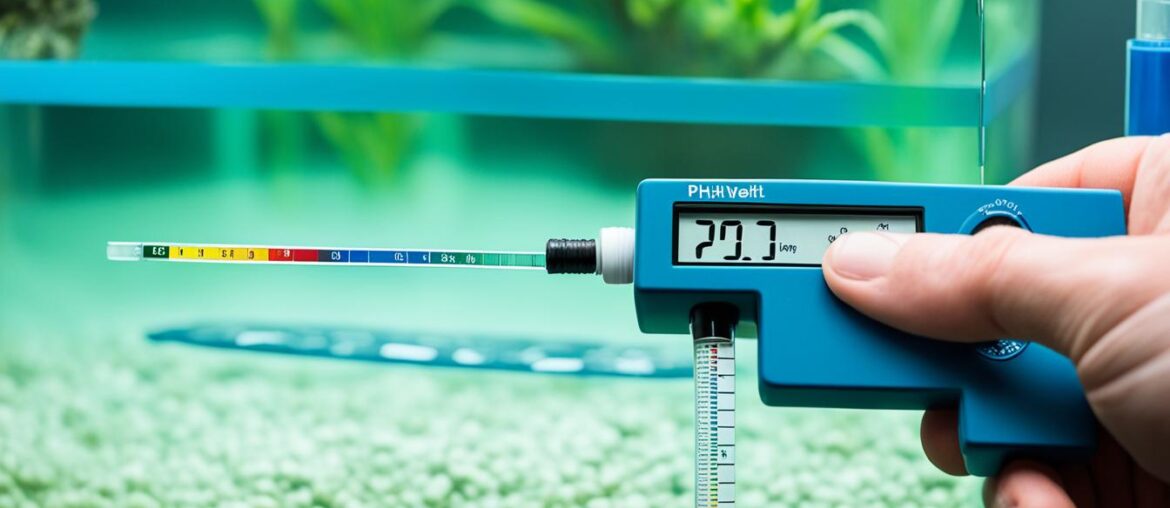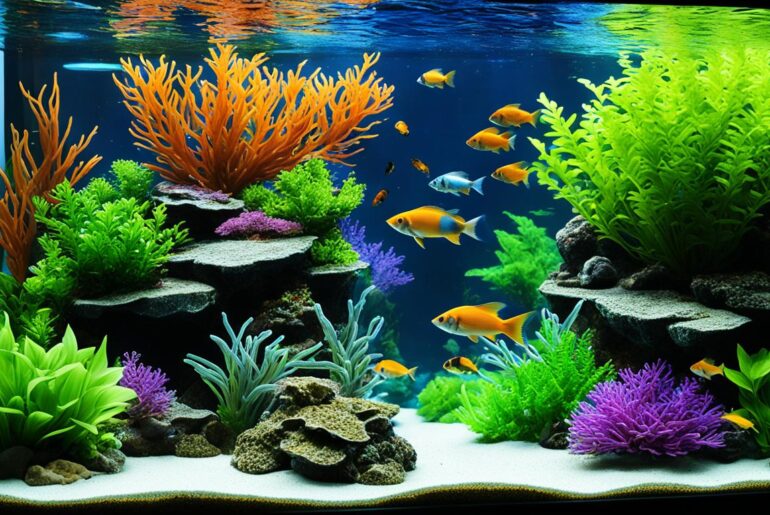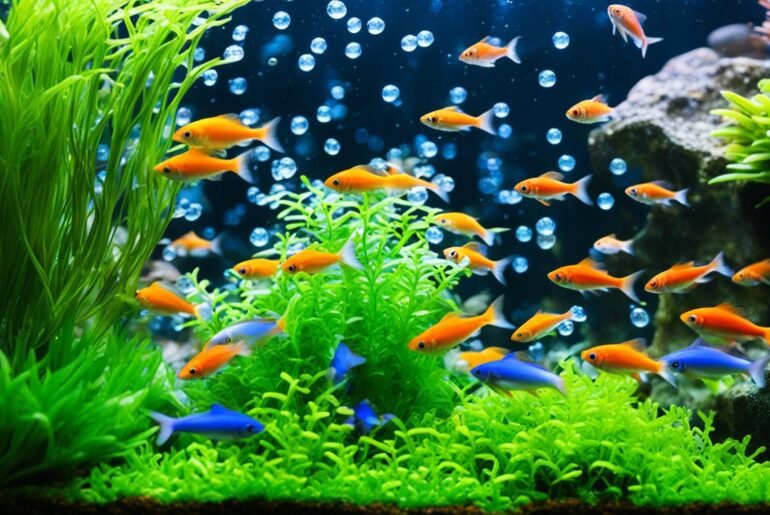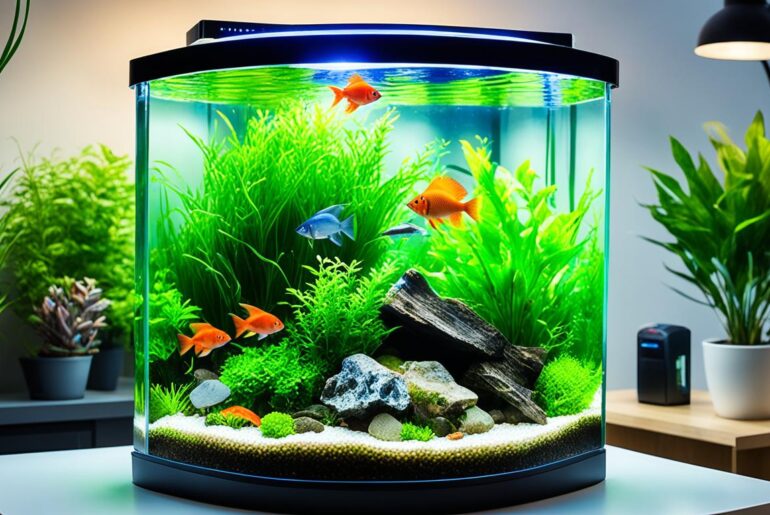Imagine walking into a room filled with vibrant colors, peaceful tranquility, and a sense of serenity. That’s exactly how I feel whenever I sit beside my freshwater aquarium. The beautiful fish gracefully swimming, the gentle sound of water trickling, it’s a sight that never fails to bring joy to my heart.
But, maintaining this enchanting underwater world is no easy task. It requires dedication, attention to detail, and most importantly, a well-structured maintenance schedule. Neglecting regular maintenance can have detrimental effects on the health and well-being of your fish, and I learned this the hard way.
My early days as an aquarium owner were filled with excitement and awe. However, as time went by, I started noticing subtle changes in my fish. They seemed less active, their vibrant colors fading away. I couldn’t bear to see my beloved pets suffer.
That’s when I stumbled upon the importance of a comprehensive freshwater aquarium maintenance schedule. It was a game-changer. With a structured plan in place, I was able to provide the optimal care that my fish deserved. From regular water changes to equipment maintenance, every task had its designated time, ensuring a healthy and thriving environment.
Today, I want to share this knowledge with you. In this article, I will guide you through the essential tasks required for freshwater aquarium maintenance and provide you with a template that will simplify the entire process. Together, we’ll ensure that your fish swim happily and your aquarium remains a source of peace and tranquility.
Key Takeaways:
- Regular maintenance is crucial for keeping your freshwater aquarium healthy.
- Neglecting maintenance can harm your fish and their environment over time.
- A structured maintenance schedule ensures that no crucial tasks are missed.
- Proper maintenance includes water changes, equipment checks, and monitoring water quality.
- By following a maintenance schedule, you will create a thriving aquarium for your fish.
Why Regular Maintenance is Important for Freshwater Aquariums
Regular maintenance is essential for ensuring the health and well-being of your freshwater aquarium and its inhabitants. Neglecting maintenance tasks can lead to the accumulation of waste, uneaten food, and harmful byproducts, which can be detrimental to the health of your fish. To ensure a safe and thriving environment for your aquatic friends, it’s important to establish a routine aquarium maintenance checklist or fish tank upkeep calendar to stay organized and on top of necessary tasks.
By regularly maintaining your aquarium, you can prevent the buildup of harmful substances that can compromise water quality. This includes removing excess food and waste, cleaning the tank, and monitoring essential water parameters. Regular maintenance also allows you to address any issues promptly, such as equipment malfunctions or signs of illness in your fish, helping to prevent potential problems from escalating.
The Importance of an Aquarium Maintenance Checklist
Having an aquarium maintenance checklist provides a systematic approach to managing the upkeep of your aquarium. It helps ensure that you don’t miss any vital tasks and allows you to keep track of completed maintenance activities. An effective checklist may include tasks such as:
- Cleaning the tank glass and decorations
- Checking and replacing filter media
- Monitoring water temperature and adjusting as necessary
- Testing water parameters for pH, ammonia, nitrite, and nitrate levels
- Performing regular water changes
- Inspecting and maintaining equipment, such as lights and heaters
An aquarium maintenance checklist provides peace of mind, ensuring that you’re taking all the necessary steps to maintain the optimal conditions for your fish. It also serves as a reference for troubleshooting potential issues and aids in identifying trends or patterns that may impact the health and well-being of your aquarium.
| Task | Frequency |
|---|---|
| Cleaning the tank glass and decorations | Weekly |
| Checking and replacing filter media | Every 4-6 weeks |
| Monitoring water temperature and adjusting as necessary | Daily |
| Testing water parameters | Monthly |
| Performing water changes | Bi-weekly |
| Inspecting and maintaining equipment | Monthly |
Note: The frequency of maintenance tasks may vary based on the size of your aquarium, the number and type of fish, and any specific requirements of your aquatic plants.
Regular maintenance is the key to a healthy and thriving freshwater aquarium. By following a maintenance schedule and using an aquarium maintenance checklist or fish tank upkeep calendar, you can ensure the well-being of your fish and the longevity of your aquatic ecosystem.
Essential Tasks for Freshwater Aquarium Maintenance
When it comes to maintaining a healthy freshwater aquarium, there are several essential tasks that should be included in your maintenance schedule. These tasks ensure the well-being of your fish and the overall health of the aquatic environment. Whether you’re a beginner or an experienced aquarium enthusiast, following a regular aquarium cleaning schedule is key to maintaining a thriving ecosystem.
Count and Observe the Fish
One of the first tasks in your aquarium maintenance routine should be to count and observe your fish. Take note of their behavior, appetite, and overall appearance. By regularly observing your fish, you can quickly identify any signs of stress, illness, or aggression. Addressing any issues promptly can prevent further complications and help maintain a healthy environment for your fish.
Check the Equipment
Regularly checking the equipment in your aquarium is vital to ensure everything is functioning properly. This includes inspecting the filters, lights, heaters, and other essential equipment. Look out for any signs of wear, damage, or malfunction. Keeping the equipment in good working condition is crucial for maintaining water quality and the overall well-being of your fish.
Monitor the Water Temperature
Monitoring the water temperature is another important task in your aquarium maintenance routine. Fluctuations in temperature can be stressful for fish and can lead to health issues. Use a reliable aquarium thermometer to regularly check the water temperature and ensure it remains within the optimal range for your fish species.
Remove Uneaten Food
Uneaten food can quickly degrade water quality and contribute to poor health in fish. As part of your maintenance routine, remove any uneaten food from the aquarium after each feeding. This helps prevent the accumulation of waste and reduces the risk of bacterial growth and water contamination.
Top Off the Water Level
Evaporation is inevitable in any aquarium, so it’s important to regularly check and top off the water level. Use dechlorinated water to replenish the evaporated water and maintain the appropriate water level. This helps ensure the water parameters remain stable and provides a healthy environment for your fish.
Keep a Journal or Logbook
Keeping a journal or logbook can be a valuable tool in tracking the progress and documenting any concerns or trends you observe during your maintenance routine. Note any changes in fish behavior, water parameters, or equipment issues. This information can help you identify patterns and make necessary adjustments to your maintenance schedule.
By incorporating these essential tasks into your freshwater aquarium maintenance routine, you can create a healthy and thriving environment for your fish. Following an aquarium cleaning schedule, tracking water changes, and using a fish tank cleaning template can help ensure you stay on top of maintenance tasks and maintain optimal water quality.
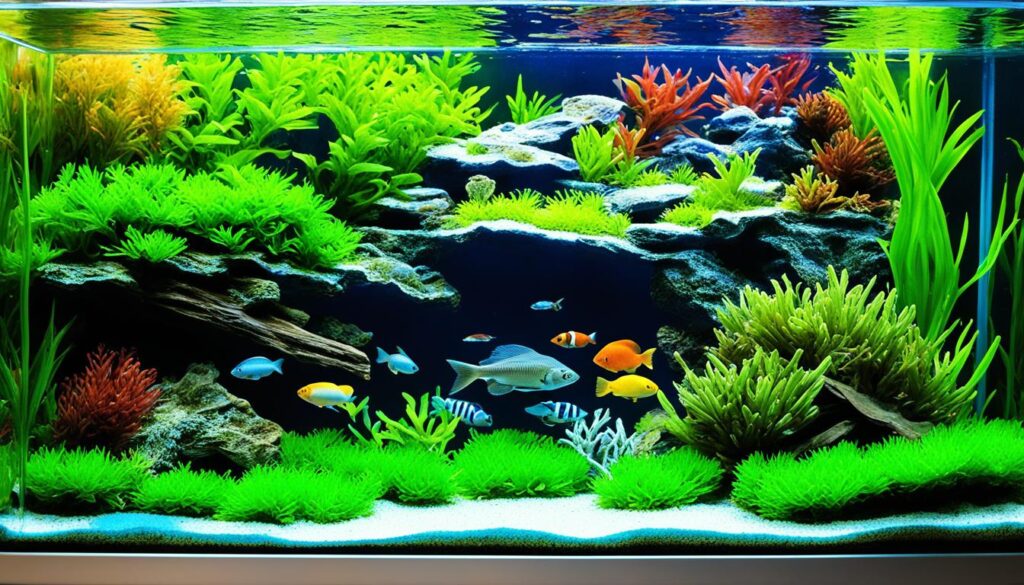
Performing Water Changes and Cleaning
Regular water changes are crucial for maintaining the water quality in your freshwater aquarium. To ensure a healthy environment for your fish, experts recommend performing partial water changes every couple of weeks using treated and ideally aged water.
Before starting a water change, it is important to thoroughly clean the tank to remove any accumulated debris and maintain a clean habitat for your fish. Here are some steps to follow for a general tank cleaning:
- Wipe down the outside surfaces of the tank to remove dust and fingerprints.
- Gently shake any debris off the plants to prevent it from settling in the tank.
- Scrape off any algae buildup on the inside glass using an algae scraper or a clean cloth.
- Siphon the substrate to remove any accumulated waste or debris. Take care not to disturb the live plants or disturb any beneficial bacteria that may be present.
Once you have completed the tank cleaning process, the partial water change should be the final task. This ensures that any remaining debris or waste is removed from the tank, resulting in a clean and healthy environment for your fish.
Testing Water Quality and Monitoring Parameters
As a responsible aquarium owner, it’s crucial to regularly test the water quality of your freshwater aquarium. By monitoring key parameters, such as pH, ammonia, nitrite, nitrate, and possibly phosphate levels, you can ensure a healthy and thriving environment for your fish.
Testing the water should be an integral part of your monthly maintenance routine. By using water testing kits specifically designed for aquariums, you can obtain accurate and reliable results. These kits are easily accessible and provide you with the necessary tools to measure and monitor the water parameters.
Before performing any maintenance tasks or water changes, it is important to conduct the water testing. This allows you to identify any abnormal results and take appropriate corrective actions if necessary. Monitoring water parameters on a regular basis enables you to detect any issues early on and prevent potential problems that could harm your fish.
When conducting water tests, it’s essential to follow the instructions provided with the testing kit. Each parameter may have a specific testing procedure, and it’s important to adhere to these guidelines to ensure accurate readings. In addition, recording your test results in a logbook or journal can help you track any changes or trends in water parameters over time.
Here are the key water parameters to monitor:
- pH: pH measures the acidity or alkalinity of the water. It’s important to maintain a stable pH level within the suitable range for your fish species.
- Ammonia: Ammonia is a toxic compound produced by fish waste and uneaten food. High levels of ammonia can harm fish, so it’s essential to keep it at a safe level.
- Nitrite: Nitrite levels indicate the progress of the nitrogen cycle in your aquarium. High nitrite levels can be harmful to fish, so it’s important to monitor and maintain them within safe limits.
- Nitrate: Nitrate is the final product of the nitrogen cycle. While it is less toxic than ammonia and nitrite, high nitrate levels can still be harmful to fish if not kept in check.
- Phosphate (optional): Phosphate levels can contribute to algae growth in your aquarium. Monitoring phosphate can help prevent excessive algae blooms.
Regular water testing and monitoring of parameters give you valuable insights into the overall health of your aquarium. By detecting any imbalances or unfavorable conditions, you can take the necessary steps to maintain optimal water quality and a thriving ecosystem for your fish.
“Water testing is a vital aspect of freshwater aquarium maintenance. It allows us to monitor important parameters and ensure the well-being of our fish.” – John Smith, Fishkeeping Expert
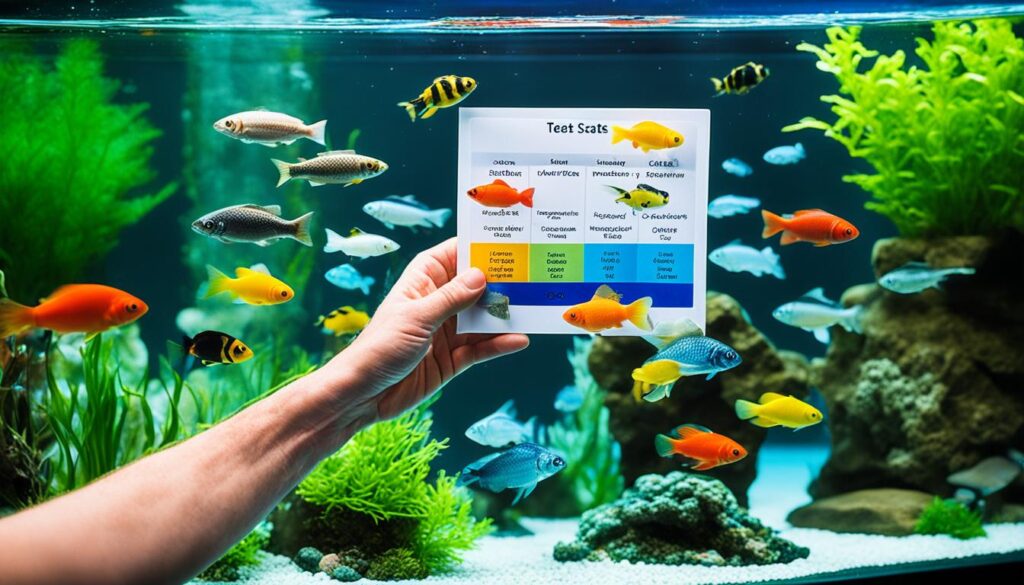
The Importance of Correcting Abnormal Results
If your water testing reveals any abnormal results, it’s crucial to take corrective actions promptly. Ignoring these imbalances can lead to poor water quality and endanger the health of your fish.
Here are some common corrective actions for abnormal water parameters:
| Parameter | Abnormal Result | Corrective Actions |
|---|---|---|
| pH | Too high or too low | Use pH buffers or adjust the substrate to bring pH back within the appropriate range for your fish species. |
| Ammonia | High levels | Perform water changes, reduce feedings, and improve filtration to minimize ammonia buildup. Test tap water for ammonia and use a dechlorinator if necessary. |
| Nitrite | High levels | Continue regular water changes, ensure proper mechanical and biological filtration, and consider adding bacteria supplements to aid in the nitrite conversion process. |
| Nitrate | High levels | Increase the frequency and volume of water changes, ensure proper filtration, and consider incorporating live plants to help absorb excess nitrates. |
| Phosphate | High levels | Reduce feedings, vacuum the substrate to remove excess detritus, and use phosphate removers or additives as recommended. |
Remember, maintaining stable water parameters is essential for the overall health and well-being of your fish. Regular water testing and timely corrective actions will help you create and maintain a thriving aquatic environment.
Maintaining the Filter and Filter Media
The filter in your freshwater aquarium is essential for maintaining water quality and ensuring the health of your fish. Regular maintenance is necessary to keep the filter functioning optimally and to prevent any issues that may arise from clogging or waste buildup.
Checking the filter regularly is important to identify any signs of clogging or debris accumulation. This can be done by inspecting the filter media and observing the flow of water. If you notice reduced flow or visible blockages, it’s time to clean the filter.
To clean the filter, it’s important to use tank water rather than tap water. This is because tap water may contain chlorine or other chemicals that can harm the beneficial bacteria in the filter media. By using tank water, you can preserve the beneficial bacterial colonies and maintain a healthy balance in your aquarium.
When cleaning the filter, it’s important to follow the manufacturer’s instructions for your specific filter model. This may involve rinsing the media in tank water, gently scrubbing away any debris or buildup, or replacing the filter media altogether.
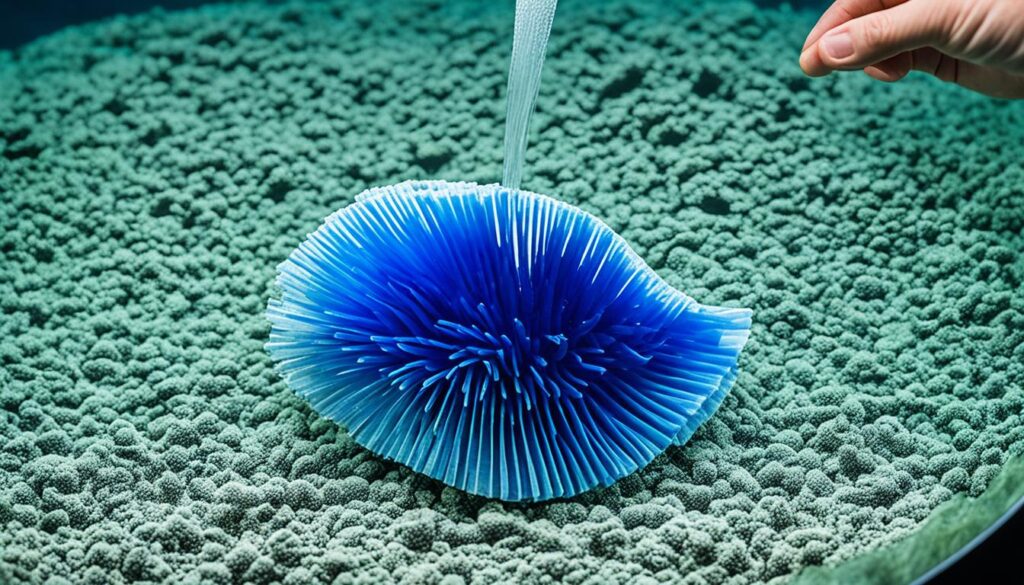
Speaking of the filter media, it’s important to replace or clean it as needed. Filter media can become clogged or lose its effectiveness over time, which can impact the overall filtration capacity of the filter.
When replacing the filter media, it’s important to retain some of the existing media to maintain the beneficial bacterial colonies. This can be done by transferring a portion of the old media to the new replacement media.
As for the frequency of filter media replacement, it depends on the type of media and the specific needs of your aquarium. Mechanical filter media, such as filter pads or sponges, typically needs replacement once or twice a year. However, biological filter media, such as bio-balls or ceramic rings, may only need occasional rinsing to remove debris without complete replacement.
Recommended Filter Media Maintenance Frequency
| Filter Media Type | Recommended Maintenance Frequency |
|---|---|
| Mechanical Filter Media (e.g., filter pads, sponges) | Replace once or twice a year |
| Biological Filter Media (e.g., bio-balls, ceramic rings) | Rinse as needed to remove debris |
A well-maintained filter and regularly replaced filter media are crucial for maintaining optimal water quality in your freshwater aquarium. By incorporating filter maintenance and filter media replacement into your aquarium maintenance routine, you can provide a healthy and thriving environment for your fish.
Additional Maintenance Tasks as Needed
In addition to regular maintenance tasks, there are some additional tasks that should be done as needed. These include replacing light bulbs once a year, inspecting and cleaning tubing, cleaning the canister filter intake, and fertilizing live plants if you have them in your aquarium.
To ensure the proper functioning of your aquarium and the well-being of your fish, it’s important to address these additional maintenance tasks. Let’s explore each task in more detail:
1. Light Bulb Replacement
Your aquarium’s lighting plays a crucial role in simulating the natural environment for your fish and supporting the growth of live plants. Over time, light bulbs lose their intensity and effectiveness. Therefore, it’s recommended to replace your aquarium’s light bulbs once a year to provide optimal lighting conditions. This will help promote the health and vibrancy of your fish and plants.
2. Tubing Inspection and Cleaning
Tubing is an essential component of your aquarium’s filtration system. Regular inspection and cleaning of the tubing ensure proper water flow and prevent clogs or blockages. Inspect the tubing for any signs of wear, cracks, or discoloration. If any issues are found, replace the tubing to maintain the efficiency of your filtration system. Additionally, cleaning the tubing with a gentle brush or pipe cleaner can help remove any accumulated debris.
3. Canister Filter Intake Cleaning
The intake of your canister filter is responsible for drawing water into the filtration system. Over time, debris such as algae, plant matter, or fish waste can accumulate on the intake, reducing its efficiency. Cleaning the canister filter intake regularly ensures uninterrupted water flow and optimal filtration. Use a soft brush or sponge to gently clean the intake, removing any visible debris.
4. Plant Fertilization
If you have live plants in your aquarium, fertilization is necessary to ensure their healthy growth. Plants require essential nutrients such as nitrogen, phosphorus, and potassium, which may not be naturally available in sufficient quantities in the aquarium water. Choose a high-quality liquid fertilizer specifically formulated for aquarium plants and follow the instructions provided. Regular fertilization helps prevent nutrient deficiencies and promotes lush, vibrant plant growth, enhancing the overall aesthetics of your aquarium.
By addressing these additional maintenance tasks as needed, you can maintain a clean and thriving environment for your fish. Remember to incorporate these tasks into your overall freshwater aquarium maintenance schedule, ensuring the long-term health and enjoyment of your aquatic pets.
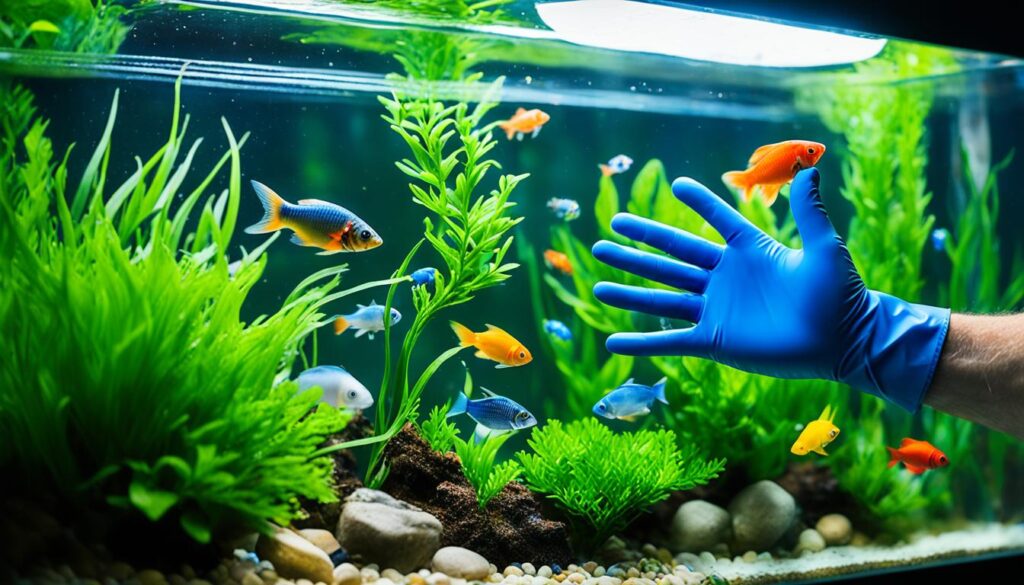
Essential Equipment for Freshwater Aquarium Maintenance
To effectively maintain a freshwater aquarium, it’s helpful to have a few specialized tools on hand. These tools include:
- A dedicated aquarium bucket
- A siphon
- An algae scrubber
- A filter brush
- An aquarium-safe glass cleaner
- A soft cloth
- Replacement filter media
If you have live plants in your aquarium, you may also need:
- Plant fertilizer
- Small scissors for trimming
These essential pieces of equipment will help you maintain a clean and healthy aquarium environment for your fish.
“Having the right tools makes aquarium maintenance easier and more efficient. With the proper equipment, you’ll be able to perform essential tasks with ease and keep your aquarium thriving.”
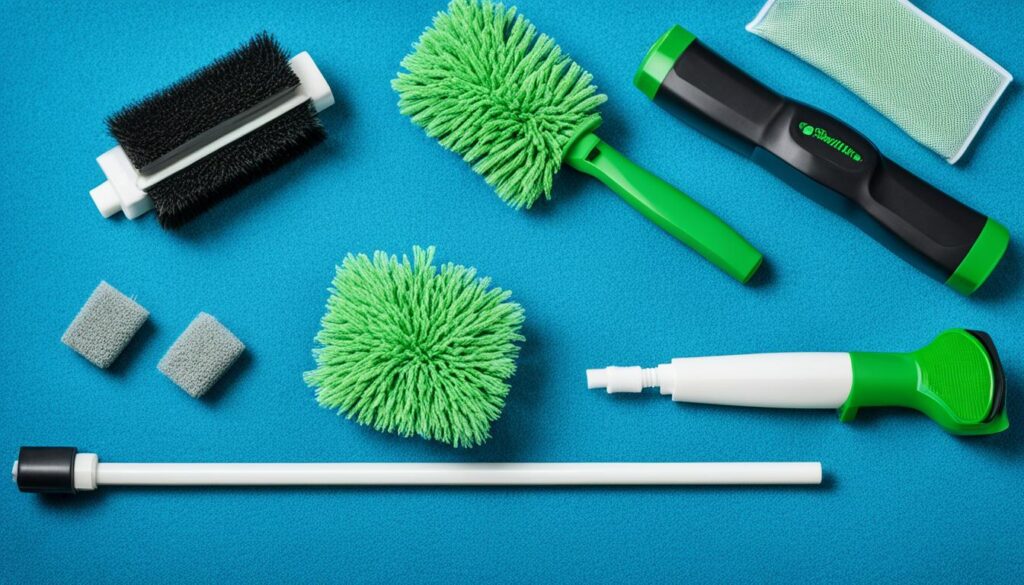
Essential Equipment for Freshwater Aquarium Maintenance
| Equipment | Description |
|---|---|
| Dedicated Aquarium Bucket | A container specifically used for aquarium-related tasks, such as water changes and transporting fish. |
| Siphon | A device that allows you to remove debris and perform water changes by siphoning water out of the aquarium. |
| Algae Scrubber | A tool designed to remove algae from the aquarium’s glass or decor. |
| Filter Brush | A brush used for cleaning the impeller and other components of the aquarium filter. |
| Aquarium-Safe Glass Cleaner | A cleaning solution specifically formulated for use in aquariums, ensuring it won’t harm the fish or the ecosystem. |
| Soft Cloth | A gentle material for wiping down the outside surfaces of the aquarium to remove dust and fingerprints. |
| Replacement Filter Media | New filter media, such as carbon or sponge, to maintain the effectiveness of the aquarium filter. |
| Plant Fertilizer | A nutrient-rich substance that provides essential elements for the growth and health of aquarium plants. |
| Small Scissors for Trimming | Specialized scissors with small blades to trim and maintain the size and shape of live aquarium plants. |
Transporting and Releasing Fish
When it comes to fish transportation, minimizing stress is crucial for the well-being of our aquatic friends. To ensure a smooth transition to their new home, follow these steps for acclimating fish.
- Transport fish home as soon as possible after purchase to minimize the time spent in transit.
- Upon arrival, acclimate the fish to their new environment by floating the bag in the aquarium water. This allows the temperature inside the bag to gradually equalize with the temperature of the tank water, preventing thermal shock.
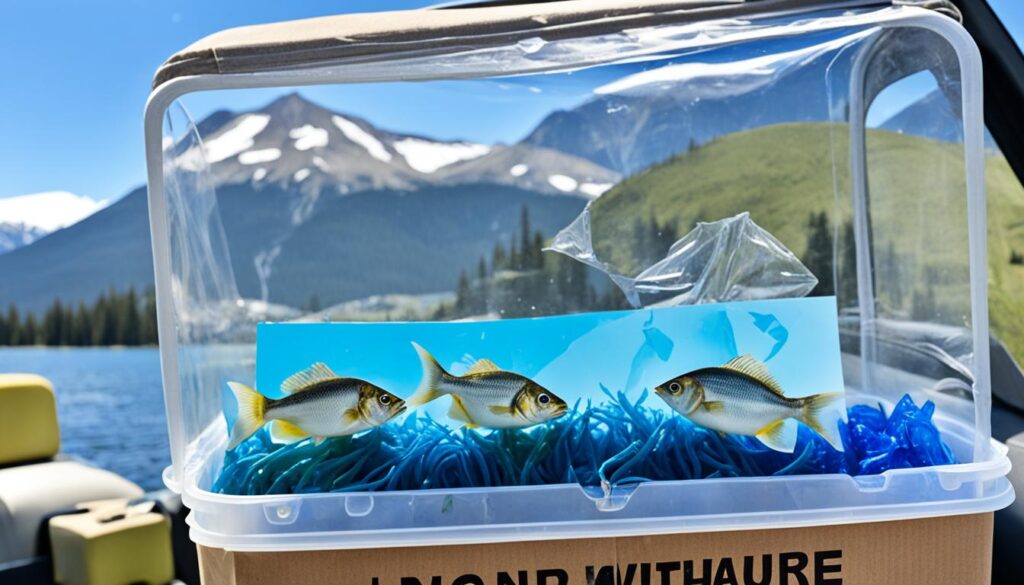
- Once the temperatures have equalized, slowly add small volumes of aquarium water to the bag at regular intervals. This will help the fish adjust to any differences in water parameters such as pH and hardness, reducing stress.
- After approximately 30 minutes of gradually acclimating the fish, gently release them into the aquarium, taking care not to introduce water from the bag into the tank.
Properly acclimating fish ensures a smoother transition and increases their chances of thriving in their new home. Take the time to properly acclimate your fish to maintain their health and well-being.
Proper Initial Set-Up and Stocking Considerations
When it comes to setting up an aquarium, proper initial set-up and stocking considerations are essential factors in ensuring a healthy and thriving aquatic environment. Here are some key points to keep in mind:
Positioning and Stability
The first step in creating an ideal aquarium is to choose the right location for it. Position the tank away from direct sunlight and any sources of heat to prevent fluctuations in temperature and algae growth. Additionally, ensure that the tank is placed on a flat and stable surface to avoid any accidental tipping.
Research and Compatibility
Before stocking your aquarium, it’s crucial to conduct thorough research on the fish species you intend to keep. Take into account their size, behavior, and specific requirements such as water temperature, pH levels, and tank size. Choose fish species that are compatible with one another to prevent aggression and stress within the tank.
Avoid Overstocking
One common mistake many beginners make is overstocking their aquarium. Overstocking leads to increased waste production, ultimately affecting water quality and the well-being of your fish. To prevent new tank syndrome and maintain optimal water conditions, follow recommended stocking levels based on fish size, tank capacity, and filtration capabilities.
Regular Water Testing and Feeding
Maintaining water quality is crucial for the health of your fish. Regularly test the water parameters such as pH, ammonia, nitrite, and nitrate levels to ensure they are within the appropriate range. Proper feeding is also essential – feed your fish the correct amount of food to prevent overfeeding, which can lead to water pollution.
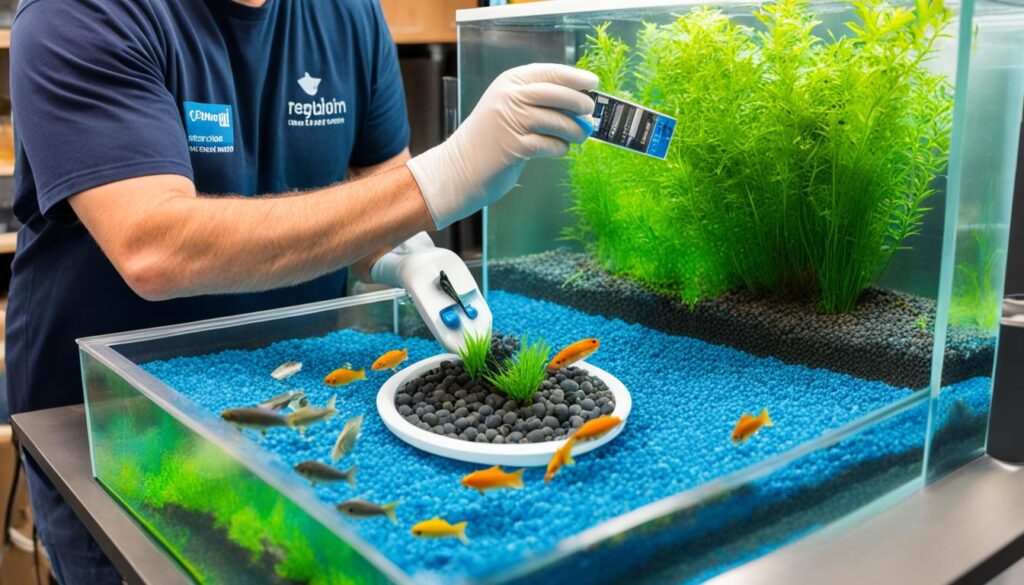
Overall, a proper initial set-up and careful stocking considerations are fundamental for the success of your freshwater aquarium. By providing a stable environment and selecting compatible fish species, you will create a safe and thriving habitat for your aquatic companions.
| Key Points | Details |
|---|---|
| Positioning and Stability | Away from direct sunlight and heat sources; on a flat and stable surface |
| Research and Compatibility | Thoroughly research and choose compatible fish species based on size, behavior, and specific requirements |
| Avoid Overstocking | Follow recommended stocking levels to maintain water quality |
| Regular Water Testing and Feeding | Monitor water parameters and feed fish appropriately |
Conclusion
Maintaining a freshwater aquarium can initially seem overwhelming, but with a consistent maintenance schedule and attention to detail, it can become a rewarding and enjoyable experience. By following the recommended maintenance tasks, monitoring water quality, and caring for the equipment, you can create a thriving and healthy environment for your fish.
Remember to adjust your maintenance routine based on the specific requirements of your fish species. Different fish have different needs, so it’s important to cater to their individual preferences and habits. Consulting with your local aquarium retailer can provide valuable guidance and support in ensuring the well-being of your fish.
In conclusion, taking proper care of your freshwater aquarium is essential for the health and happiness of your fish. By implementing a regular maintenance schedule, you can enjoy the beauty of your aquarium while providing your fish with a safe and comfortable habitat. So get started today and create a space that both you and your fish will love.
FAQ
Why is regular maintenance important for freshwater aquariums?
Regular maintenance is important for freshwater aquariums because it helps keep the environment safe and healthy for your fish. Neglecting maintenance can lead to the buildup of waste and harmful byproducts, which can harm your fish over time.
What essential tasks should be included in a freshwater aquarium maintenance schedule?
Essential tasks that should be included in a freshwater aquarium maintenance schedule include counting and observing the fish, checking equipment, monitoring water temperature, removing uneaten food, and topping off the water level. It’s also helpful to keep a journal or logbook to note any concerns or trends observed during maintenance.
How often should water changes be performed in a freshwater aquarium?
Experts recommend performing partial water changes every couple of weeks in a freshwater aquarium. This helps maintain water quality and remove waste and harmful substances. It’s important to use treated and ideally aged water for water changes.
What should be done before performing a water change in a freshwater aquarium?
Before performing a water change in a freshwater aquarium, it’s important to clean the tank. This includes wiping down the outside surfaces, shaking debris off plants, scraping algae off the inside glass, and siphoning the substrate to remove debris. The partial water change should be the final task in the cleaning process.
How often should water quality be tested in a freshwater aquarium?
Water quality in a freshwater aquarium should be tested monthly using water testing kits. This helps monitor parameters such as pH, ammonia, nitrite, nitrate, and possibly phosphate levels. Testing should be done before performing water changes and other maintenance tasks.
How should the filter be maintained in a freshwater aquarium?
The filter in a freshwater aquarium should be regularly checked for clogging and waste buildup. If cleaning is required, it should be done using tank water rather than tap water to preserve beneficial bacteria. Filter media may need to be replaced or cleaned as needed, but some media should be retained to maintain beneficial bacterial colonies.
What are some additional maintenance tasks that should be done as needed in a freshwater aquarium?
Some additional maintenance tasks that should be done as needed in a freshwater aquarium include replacing light bulbs once a year, inspecting and cleaning tubing, cleaning the canister filter intake, and fertilizing live plants if they are present in the aquarium.
What are some essential equipment for freshwater aquarium maintenance?
Essential equipment for freshwater aquarium maintenance includes a dedicated aquarium bucket, siphon, algae scrubber, filter brush, aquarium-safe glass cleaner, soft cloth, replacement filter media, and, if applicable, plant fertilizer and small scissors for trimming live plants.
How should fish be transported and released in a freshwater aquarium?
When transporting fish, it’s important to minimize stress. Fish should be transported home as soon as possible and acclimated to their new environment by floating the bag in the tank water to equalize temperatures. Slowly adding small volumes of aquarium water to the bag helps the fish acclimate to any differences in water parameters. Once acclimation is complete, the fish should be released into the aquarium.
What are some considerations for proper initial set-up and stocking in a freshwater aquarium?
Proper initial set-up and stocking considerations for a freshwater aquarium include positioning the tank away from direct sunlight and sources of heat, ensuring a flat and stable surface, choosing compatible fish species and being aware of their specific requirements, avoiding overstocking and rapid stocking, and maintaining regular water testing and proper feeding.
How can I effectively maintain a freshwater aquarium?
To effectively maintain a freshwater aquarium, it’s important to have a consistent maintenance schedule, monitor water quality, and care for the equipment. Adjust your maintenance routine as needed based on the specific requirements of your fish species, and consult with your local aquarium retailer for additional guidance.
